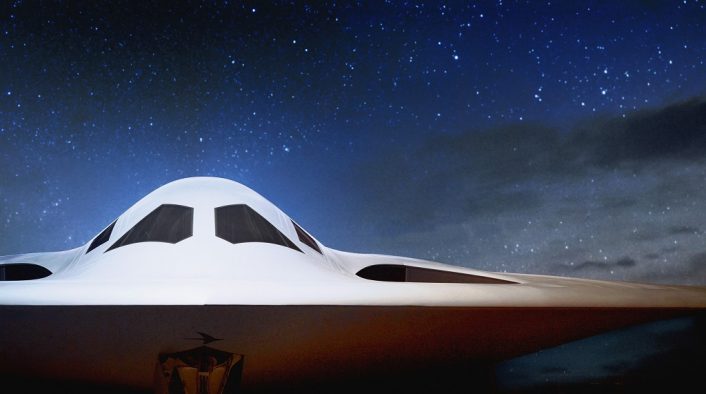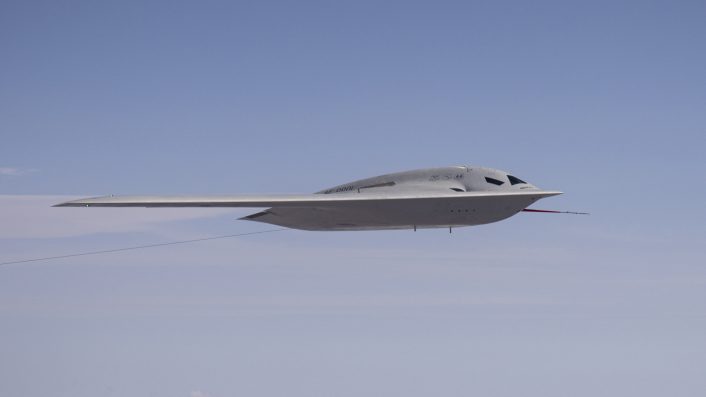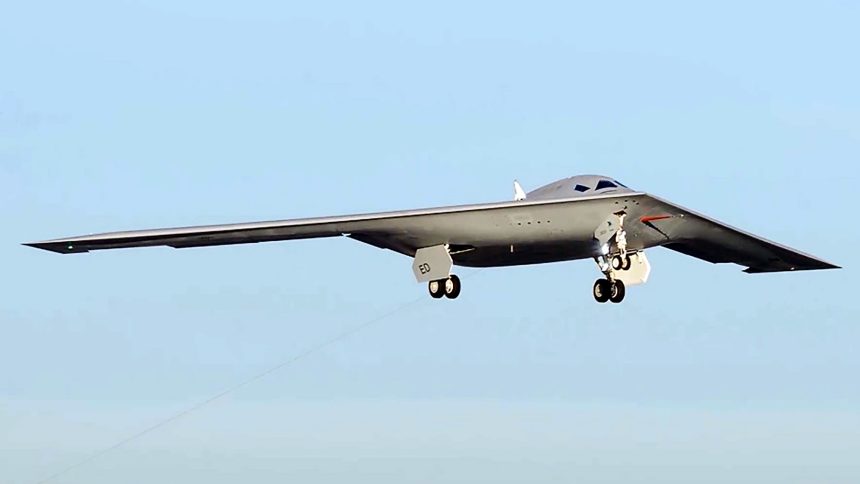As part of the review of its future air superiority concept, the U.S. Air Force is evaluating a larger role for the B-21 Raider. The size of the fleet on order, however, is set to stay at 100 aircraft, at least for the time being and until the ongoing review of the NGAD continues.
Amid a review of the technically complex and astronomically pricey sixth generation NGAD (Next Generation Air Dominance), the U.S. Air Force is considering an expanded role for the B-21 Raider. U.S. Air Force chief General David Allvin’s comments to journalists during the Military Reporters and Editors conference on Oct. 25, 2024, suggested what could be translated as new air dominance and air-to-air missions for the Raider.
The Northrop Grumman-developed strategic bomber, meant to replace the B-2 Spirit and the B-1B Lancer, has also been described as the world’s first sixth generation aircraft. The service has announced it would order 100 units of the B-21, with various estimates putting the price tag over $780 million per aircraft. In June, Northrop Grumman and the government negotiated a “not-to-exceed” price for the additional 19 aircraft, which is more than the average unit price of the first five LRIP (Low-Rate Initial Production) lot of 21 aircraft.
The NGAD, considered a replacement for the F-22, is usually described as a “family of systems,” including the crewed aircraft as well as autonomous, unmanned ‘wingmen’ drones for ISR, decoy or strike missions and other disaggregated capabilities. Called CCAs (Collaborative Combat Aircraft), these drones are considered part of the family of systems, and are funded as an integral element of the NGAD program.
“The Air Force is reconsidering how it gains air superiority—and whether it needs a manned sixth-generation fighter to achieve it, acquisition boss Andrew P. Hunter said.”https://t.co/KKcDwu8MNx https://t.co/hk2xodRmQ3 pic.twitter.com/XKXlneFgpz
— Doha (@Doha104p3) September 4, 2024
However, reports since this summer have revealed a relook towards the NGAD program, whose manned aircraft are estimated to cost $300 million apiece, while also balancing the B-21 Raider and the Sentinel ICBM. The NGAD figure is almost three times that of an F-35, whose price is between $80 and $100 million apiece.
‘Not ruling out dominance role for B-21 Raider’
According to Air Force Times, the Raider “could end up having a larger role in the Air Force’s plans for future air dominance, as the service rethinks its plans for an advanced sixth-generation fighter.” Responding to a question by the publication whether the NGAD’s ongoing review would mean a prominent role for the B-21 in the air dominance role, Gen. Allvin said: “We have not taken that off the table.”
Allvin did not explicitly state either air dominance or air-to-air combat roles. However, given the context of the question, he might have alluded to that possibility. For now, the bomber, which has advanced data linking technologies and features open architecture and digital engineering for rapid upgrades and repairs, would appear to be limited to strategic airborne conventional and nuclear strike roles, with the dominance role subject to the NGAD review.
Interestingly, this is also not the first time that the Air Force has implied a possible air-dominance role for the B-21 Raider. In a Sep. 2019 interview to Air and Space Forces Magazine, then Maj. Gen. Scott Pleus said: “If we were to characterize it as a fighter, we would be thinking too narrowly about what kind of airplane we need in a highly contested environment.”
The B-21 “Raider” bomber, rendered to the best public level of detail and shown launching JASSM stealth cruise missiles.
It took artist ‘Deca’ 177 days of effort to create this.#art https://t.co/IvGcUu2OkA pic.twitter.com/5wPa5wsKud
— ToughSF (@ToughSf) September 10, 2024
“A B-21 that also has air-to-air capabilities” and the ability “to work with the family of systems to defend itself, utilizing stealth – maybe that’s where the sixth-generation airplane comes from,” Pleus, at the time the Pacific Air Forces Director of Air and Cyber Operations, told ASF.
Pleus’ comments could also serve to address the ongoing – and still inconclusive – theoretical debate about what constitutes a sixth generation jet. Nevertheless, there is no reason it might not serve to define the capabilities and missions of what is officially described as the world’s first sixth generation aircraft.

How will a Raider work in an air-to-air role?
An air-to-air role for the B-21 Raider, if that is what means “expanded” role as per Allvin, could be similar to the arsenal plane concept envisaged for the C-17 Globemaster III, B-52H Stratofortress or the B-1B Lancer bomber. The heavy-carrying planes, generally flying in formation, would simply release volleys of air-launched standoff land-strike cruise missiles to overwhelm air defenses and take out critical land targets. The Rapid Dragon is one such concept envisioned for the U.S. Air Force’s cargo fleet, firing the AGM-158 JASSM (Joint Air-to-Surface Standoff Missile).
In an air-to-air role, the B-21 Raider could carry ultra-long range AAMs (Air-to-Air Missiles) like the secretive AIM-260 JATM (Joint Advanced Tactical Missile), once it is fielded, for engaging large formations of enemy fighters. The goal might not be necessarily to shoot them down, but perhaps to keep them in a self-defensive stance and force them to perform evasive maneuvers, eating away time from core combat tasks.
The US Air Force and Northrop Grumman are testing the newest B-21 Raider bomber. Photos of the handsome Ryder.
At the moment, the Air Force is expected to receive six pre-production B-21s, and the total number of aircraft after acceptance into service should be at least 100. pic.twitter.com/EcPT0bzEGN
— Dana Levi דנה🇮🇱🇺🇸 (@Danale) October 26, 2024
Radar-killing roles
The ‘expanded’ role might also involve the Raider firing swarms of radar-baiting decoys or other munitions in SEAD/DEAD missions. This hypothesis follows the sparse official descriptions of the B-21 having advanced sensor fusion and data processing and implying an AD (Air Defense) breaching role for standoff strikes. That electromagnetic sensing and computing power could also be extended for radar-killing with own on-board munitions.
A previous report about supporting infrastructure for the B-21 Raider, which involved fuel cell maintenance bays, suggested how the powerful power-generation devices on-board could be used for these very sensors that would require massive amounts of energy.
Moreover, SEAD/DEAD weapons like the AGM-88 HARM (High-Speed Anti-Radiation Missile), AGM-88E AARGM (Advanced Anti-Radiation Guided Missile) or even the MALD (Miniature Air-Launched Decoys) paired with the Raider’s immensely powerful sensors would be a lethal combination for China’s integrated air defense network. Of course, it remains to be seen if these munitions would be carried by the Raider or the CCAs that would be flying alongside it.
In fact, the bomber’s internal racks and launchers would possibly be only for land-strike munitions and would have to be swapped out for AAM or SEAD/DEAD ones. However, it is still unknown what and how much the B-21’s bays can carry, given how both Northrop Grumman and the USAF have been extremely secretive about its technical specifications.
How the USAF repurposes the Raider for a non-core strategic bombing role remains to be seen. Until then, the next few months would show if the service’s ongoing review of the NGAD might or might not have a relationship with the B-21.

More B-21s?
While Gen. Allvin did not mention further B-21 acquisitions and Air Force officials said that 100 Raiders are sufficient to the current operational needs, Northrop Grumman CEO Kathy Warden commented that the service might be looking at reconsidering the final number of the bombers. In fact, Air Force Secretary Frank Kendall said that the service is looking at options to increase the force size as part of the force structure design review.
The Secretary has specifically mentioned NGAD, however Warden said the B-21 “is in the mix as well.” “It would be premature for me to suggest where that force structure review will end up,” said Warden. “But I do think in the coming months, we may get a better indication from the Air Force as to how they’re thinking about B-21 quantities in the long run.”
Should the service decide to increase the number of the new bombers, Warden said Northrop Grumman stands ready to increase B-21 production. The CEO also mentioned she expects the Air Force to award a second LRIP contract by the end of the year.









